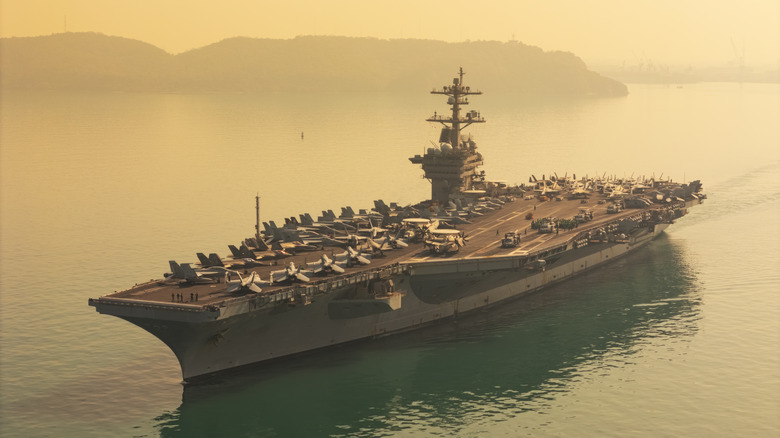
Refueling an aircraft carrier isn't like pulling up to a gas station. In fact, for nuclear-powered carriers, the process is so involved and intense that it only happens once in the ship's entire 50-year service life. The process is called an RCOH, or Refueling and Complex Overhaul, and it's anything but quick. Depending on the ship's condition and the scope of upgrades, RCOH can stretch out for three to four years -- in some cases, even up to six years. This is what happened with the USS George Washington,
which carries a crew of 5,980.
But the name "refueling" doesn't really do justice to what's actually going on. Along with replacing the nuclear fuel, the Navy uses this once-in-decades event to completely overhaul the ship from top to bottom. Systems are upgraded, old parts are ripped out and replaced, and nearly every square foot is inspected and repaired. Basically, it's not just maintenance, but a total reboot that costs hundreds of millions of dollars and takes years of planning to pull off. This is just one of many interesting facts you probably didn't know about aircraft carriers.
Read more: 10 Of The Largest Navies In The World, Ranked By Self-Reported Total Naval Assets
Why It Takes So Long To Refuel A Carrier

Nuclear aircraft carriers, such as those in the Nimitz class, are powered by two massive reactors, which are strong enough to run everything onboard -- from lights and engines to radar systems -- for more than 20 years without needing new fuel. This is about how long an aircraft carrier can stay at sea without refueling. But when that time comes, the process is complex and risky. First, the reactors must be cooled down and shut off, which takes days. Then, workers carefully remove the hundreds of radioactive fuel rods, following strict safety procedures. This all happens in dry docks, where the entire ship is drained of water and lifted above for inspection.
The only shipyard in the U.S. that handles this job is Newport News Shipbuilding in Virginia. Here, teams work around the clock using massive cranes and special tools to dismantle reactor parts, remove the old core, and install the new fuel. But RCOH isn't just about fuel. In fact, it's the Navy's once-in-a-lifetime chance to modernize everything: combat systems, electronics, radar arrays, software, fire controls, and even the ship's wiring. It's the only time in 25 years that they can get to some of the ship's deepest systems, which is why they don't take any shortcuts.
A One-Time Reboot For A 50-Year Service Life

Usually, each aircraft carrier only gets one RCOH in its lifetime -- right around the 25-year mark. After that, it's good to go for another two decades or more. The USS Nimitz, the oldest U.S. aircraft carrier still in service, was one of the first carriers to undergo this process. As of 2023, the USS John C. Stennis is undergoing its own RCOH. At any given time, up to three carriers might be out of rotation, going through this massive overhaul.
Because of this rotation, the Navy is able to keep seven or eight carriers ready at all times out of the 11 total in its fleet. The goal is to ensure global presence and power projection, no matter what. And thanks to nuclear propulsion, these ships can run clean, emitting only water vapor without needing fossil fuels or constant refueling like older diesel-powered ships once did. It's a long wait, but for a ship expected to serve half a century, a few years in the dry dock is just part of the plan.
Want the latest in tech and auto trends? Subscribe to our free newsletter for the latest headlines, expert guides, and how-to tips, one email at a time.
Read the original article on SlashGear.













